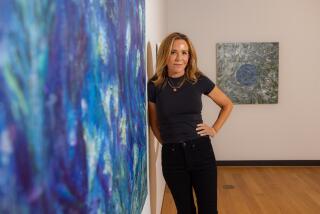Artist in Residence Is Building Her ‘Nest’
Barbara Chase-Riboud apologizes about the tedious pace of constructing one of her sculptures. No theatrical flourishes here, flinging gobs of clay or chunks of metal onto a pedestal. Creating a Chase-Riboud is a slow, incremental process, something like building a nest.
“Little by little, you begin to have something that looks like a sculpture, I hope,” she says.
This is in a paint-spattered studio at Pasadena City College, where Chase-Riboud was serving last week as the art department’s fourth annual Artist in Residence. The sculptor spent much of her residency cutting strips of wax, shaping them into whorls and painstakingly fitting them onto a board, the sum of which would ultimately be cast in bronze.
On the busy Pasadena campus, the yearly Artist in Residence program has become the art world equivalent of a “star turn”--like Katharine Hepburn performing a cameo role in an ensemble production or Pavarotti stepping out of the audience to sing a brief aria.
Famous artist lectures on art, exhibits her works in the College Art Gallery, socializes on the wine-and-cheese circuit and, in the allotted week, creates a new work of art--all within the confines of a bustling suburban campus.
For Chase-Riboud, it was exhilarating. “I’m having a great time,” said the Philadelphia-born sculptor.
Chase-Riboud, 50, is not only a widely admired artist whose monumental constructions of bronze shards, woven silk and hammered aluminum are in the permanent collections of, among others, the Museum of Modern Art and the Metropolitan Museum of Art in New York. She is also a respected historical novelist.
Her books include “Sally Hemings,” the story of Thomas Jefferson’s mulatto lover, which won the Kafka Award for the best novel written by an American woman in 1979 and sent waves of controversy through some staid academic circles. Her most recent book was last year’s “Echo of Lions,” the story of a shipboard slave rebellion, also based on historical fact. She has also written poetry, winning the Carl Sandburg Poetry Prize in 1988.
It seemed inevitable back in Philadelphia that Chase-Riboud would land somewhere in the arts. With dance classes at 5, piano lessons at 6 and art lessons at 7, she describes herself as a prime “art brat.”
Chase-Riboud won scholarships to the Tyler Art School at Temple University and the Yale School of Art and Architecture, where she earned a master’s in fine arts in 1960.
She took up residence in Europe in 1960 and now splits her time between Paris and Rome.
In her sculptures, Chase-Riboud uses a propane torch, a hot plate and some carving tools, including a kitchen knife. She slices the wax with a hot knife or melts the edges with the torch.
A student persists in asking her about her philosophy of art. “It’s hard to verbalize,” she says. “If artists could verbalize, they’d write.” She pauses for a moment, apparently remembering that she is also a writer.
“As far as I’m concerned, it’s the beauty of the object,” she says. “The poetry and the mystery.”
More to Read
The biggest entertainment stories
Get our big stories about Hollywood, film, television, music, arts, culture and more right in your inbox as soon as they publish.
You may occasionally receive promotional content from the Los Angeles Times.










